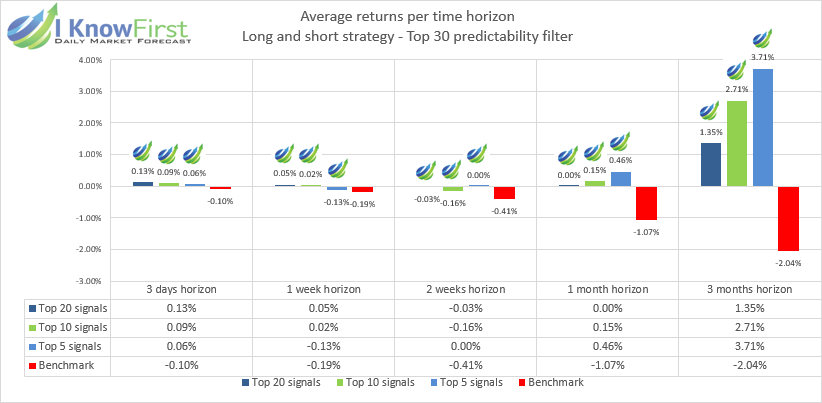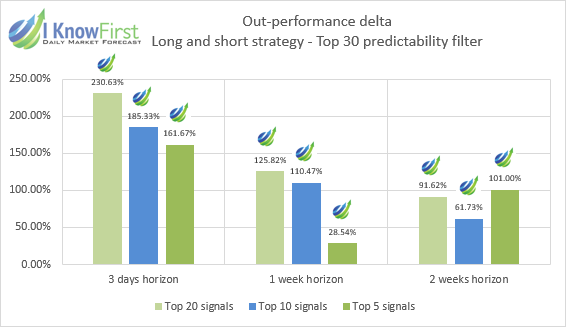I Know First Live Forecast Evaluation Report For MSCI EMU Stock Universe – Significantly Beating The Benchmark
Executive Summary
In this live forecast evaluation report we will examine the performance of the forecasts for the first time generated by the I Know First AI Algorithm for the MSCI EMU stock universe which was sent to our clients. Our analysis covers time period from January 1, 2018 to November 1, 2018. We will start with an introduction to our stock picking and benchmarking methods and then apply it to the MSCI EMU stock universe.
MSCI EMU Stocks’ Universe Highlights
- Signal indicator filter applied to Top 30 most predictable stocks provides the highest return of 3.71% for Top 5 stocks on 3-months’ investment horizon
- There is a clear increasing trend for returns improvement with the time horizon increase – the return for all stocks beat the benchmark
- The Top 5 stocks on 3-month’s investment horizon significantly out-perform the benchmark by 5.75%
The above results were obtained based on forecasts’ evaluation over the specific time period using consecutive filtering approach – by predictability, then by signal, to give general overview of the forecasting capabilities of the algorithm for specific stock universe. The following sections of this study will develop the analysis and the data behind the above results and provide you with deeper understanding of the Methodology and the filtering results for different subsets of assets.
About the I Know First Algorithm

The I Know First self-learning algorithm analyses, models, and predicts the stock market. The algorithm is based on Artificial Intelligence (AI) and Machine Learning (ML) and incorporates elements of Artificial Neural Networks and Genetic Algorithms.
The system outputs the predicted trend as a number, positive or negative, along with a wave chart that predicts how the waves will overlap the trend. This helps the trader to decide which direction to trade, at what point to enter the trade, and when to exit. Since the model is 100% empirical, the results are based only on factual data, thereby avoiding any biases or emotions that may accompany human derived assumptions. The human factor is only involved in building the mathematical framework and providing the initial set of inputs and outputs to the system. The algorithm produces a forecast with a signal and a predictability indicator. The signal is the number in the middle of the box. The predictability is the number at the bottom of the box. At the top, a specific asset is identified. This format is consistent across all predictions.
Our algorithm provides two independent indicators for each asset – Signal and Predictability.
The Signal is the predicted strength and direction of movement of the asset, measured from -inf to +inf.
The predictability indicates our confidence in that result. It is a Pearson correlation coefficient between past algorithmic performance and actual market movement measured from -1 to 1.
Here is the detailed description of the heatmap.
The Stock Picking Method
The method in this evaluation is as follows:
We take the top X most predictable assets, and from them we pick the top Y highest signals.
By doing so we focus on the most predictable assets on the one hand, while capturing the ones with the highest signal on the other.
For example, a top 30 predictability filter with a top 10 signal filter means that on each day we take only the 30 most predictable assets, and then we pick from them the top 10 assets with the highest absolute signals.
We use absolute signals since these strategies are long and short ones. If the signal is positive, then we buy and, if negative, we short.
The Performance Evaluation Method
We perform evaluations on the individual forecast level. It means that we calculate what would be the return of each forecast we have issued for each horizon in the testing period. Then, we take the average of those results by strategy and forecast horizon.
For example, to evaluate the performance of our 1-month forecasts, we calculate the return of each trade by using this formula:
This simulates a client purchasing the asset based on our prediction and selling it exactly 1 month in the future.
We iterate this calculation for all trading days in the analyzed period and average the results.
Note that this evaluation does not take a set portfolio and follow it. This is a different evaluation method at the individual forecast level.
The Benchmarking Method
The theory behind our benchmarking method is the “Null hypothesis“, meaning buying every stock in the particular asset universe regardless of our I Know First indicators.
In comparison, only when our signals are of high signal strength and high predictability, then the particular stocks should be bought (or shorted).
The ratio of our signals trading results to benchmark results indicates the quality of the system and our indicators.
Example: A benchmark for the 3d horizon means buy on each day and sell exactly 3 business days afterwards. We then average the results to get the benchmark. This is in order to get an apples to apples comparison.
MSCI EMU
The MSCI EMU Index is a market capitalization weighted index, provided by Morgan Stanley Capital International (MSCI). It is an equity index which has all the largest companies from the Eurozone. The index includes around 248 constituents, which represent approximately 85 percent of the total market capitalization of the Eurozone. As of June 2008, the MSCI EMU Index contained stocks from the following countries: Austria, Belgium, Finland, France, Germany, Greece, Ireland, Italy, the Netherlands, Portugal and Spain. The total index contains almost 300 stocks. With a share of 32.80 percent, France holds the largest percent in the index, followed by Germany with 30.19 % and the Netherland with 10.96 %. In terms of industry makeup, the MSCI EMU is clearly most reliant on financials services with 20.27 %, followed by industrials at 15.18 % and consumer discretionary with 13.85 %.
For more information about the MSCI EMU, click here.
Evaluating the predictability indicator
We conduct our research for the period from January 1, 2018 to November 1, 2018. Following the methodology described in the previous sections, we start our analysis with computing the performance of the algorithm’s long and short signals for time horizons ranging from 3 days to 3 months without considering the signal indicator. Therefore, we applied filtering by the predictability indicator for 5 different levels to investigate its sole marginal effect in terms of return when different filters are applied. Afterwards, we calculated the returns for the same time horizons of the benchmark compared them to the performance of the filtered sets of assets. Our findings are summarized in the table below:
MSCI EMU Predictability Effect on Return
Average returns per time horizon (3 days to 2 weeks), only predictability filter
Average returns per time horizon (1 month to 3 months)
From the above charts we can observe that in 3 out of 5 of the considered time horizons the marginal predictability effect increases with the narrowing of the asset subsets from the Top 50 assets to the Top 30 assets filtered by predictability. In comparison with the benchmark based on all assets from each of the considered assets’ universes, we can see that just by applying the predictability indicator as an investment criterion without consideration of the signal strength, already yields positive return and outperforms the benchmark by almost 3% in case of Top 50 stock by predictability criterion on 3-months’ horizon.
Evaluating the Signal indicator
In this section we will demonstrate how adding the signal indicator to our stock picking method improves the above performance even further. It is also important to measure the outperformance relative to the benchmark and for that we will apply the formula:

Therefore, we applied filtering by signal strength to the Top 30 assets filtered previously by predictability. The results of the testing showed that there is a significant positive marginal effect on the assets return, especially in the case of the 3-months’ investment horizon. We present our findings in the following table and charts.
MSCI EMU Key Performance Indicators Summary
Average returns per time horizon (3 days to 2 weeks), predictability & signal filters
Average returns per time horizon (1 month and 3 months), predictability & signal filters
Out-performance per time horizon (3 days to 3 months)
Average hit ratio per time horizon, predictability & signal filters
From the above set of charts, we can clearly see that if we apply signal strength filtering to the MSCI EMU stocks universe, all the subsets will start to produce greater returns than the benchmark with increase of time horizon. As soon as we start to consider 3-months’ time horizon, we see that the returns of the Top 5 and Top 10 subsets make significant jump comparing to the shorter periods and ultimately reaches 3.71% and 2.71% by Top 5 and Top 10 on 3-months’ horizon, respectively. Finally, the hit ratio follows the similar pattern and we observe its peak values for Top 5 at 62.36% and Top 10 at 59.33% on 3-month time horizon, beating all signals, which contain the Top 30 signals, by around 7% and 5%, respectively.
Conclusion
In this analysis, we demonstrated the out-performance of our forecasts by I Know First’s AI Algorithm from the MSCI EMU index universe for the period from January 1, 2018 to November 1, 2018. Based on the presented observations we record significant out-performance of the Top 30 stocks filtered by predictability for all time horizons for the considered asset universe, even without filtering by signal strength.
Applying our predictability indicator as an investment criterion coupled with filtering by our signal strength, results in even greater out-performance over the benchmark. That said, the Top 5 stocks from the MSCI EMU index universe filtered by predictability and signal yield significantly higher returns than any other asset subset on almost all considered time horizons spanning from 3 days to 3 months. Therefore, an investor who wants to critically improve the structure of his investments by adding stocks being traded in the Eurozone to his portfolio can do so by simultaneously utilizing the I Know First predictability and signal indicators as criteria for picking stocks.























